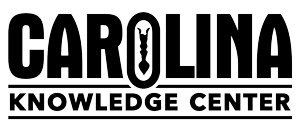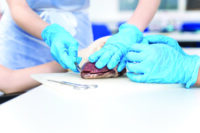When chemistry or physical science students initially learn about chemical changes and chemical reactions, they are taught to look for evidence of the change or reaction. Chemical changes, or reactions, are the result of breaking bonds in the starting substances, called reactants, and the rearrangement of those substances and bonds to make new substances, called products.
The rearrangement of reactants into products is usually accompanied by some type of observable or measurable indicator. Students often look for:
- Color changes
- Temperature changes
- Formation of a solid product or precipitate
- Production of heat
- Production of light
- Sound
- Bubbles indicating gas formation
Presenting students a variety of reactions, with easily observable indicators, encourages them to develop and use a predictive model of reaction types. Carolina ChemKits®: Types of Chemical Reactions provides students with reliable, safe examples of chemical reactions and guides them through the process of predicting the reaction products. With practice, students become adept at analyzing observable indicators to identify the different types of chemical reactions.
Carbon Dioxide
Reactions that produce carbon dioxide gas
As students move through the reaction identification process, they should associate the production of bubbles with the production of a gaseous product. Refinement of reaction type models can help students identify the actual gaseous product. Since the production of carbon dioxide in biological processes like respiration and the chemical weathering reactions of minerals like calcite may already be familiar to students, we will look at reactions that produce carbon dioxide first.
Examples of reactions that produce CO2
Decomposition of metallic carbonates M = reactive metal
MCO3→ MO + CO2(g)
Decomposition of metallic hydrogen carbonates or metallic bicarbonates
MHCO3 → MCO3 + H2O + CO2(g)
Combustion of a hydrocarbon
CxHy + O2 → H2O + CO2(g)
Students should recognize the relationship between the carbonate ion (CO32-), its chemical stability, and the production of carbon dioxide gas. If you need additional cross-curricular activities, you may want students to:
- Investigate how the production of carbon dioxide by algae during photosynthesis affects the pH of water using Carolina BioKits®: Algae Bead Photosynthesis
- Examine chemical weathering of limestone with Carolina Investigations® for AP® Environmental Science: Soil Formation and Properties
Oxygen
Reactions that produce oxygen gas
Oxygen, as a gaseous product, is formed from several different types of reactions including decomposition and photosynthesis. Again, the photosynthesis equation is a useful cross-curricular example of a reaction that produces oxygen. Earth science or geology students may be familiar with decomposition of metal oxides if they learned about mining and ore refinement. The decomposition of water through electrolysis is a tried-and-true demonstration, both for the technique and identification of the products. Students are probably familiar with hydrogen peroxide as a cleaning solution for cuts and scrapes. They may realize hydrogen peroxide decomposes in sunlight so it must be stored in a brown bottle. With a catalyst, the decomposition of the compound is rapid and makes a showstopping demonstration known as elephant toothpaste.
Examples of reactions that produce O2
Decomposition of metallic chlorates
MClO3 → MCl + O2(g)
Electrolysis of H2O
2H2O → 2H2 + O2(g)
Decomposition of metal oxides
MO → M + O2(g)
Photosynthesis
CO2 + H2O → C6H12O6 + O2(g)
Decomposition of hydrogen peroxide
2H2O2 → 2H2O + O2
Hydrogen
Reactions that produce hydrogen gas
If students have chemistry experience with acids and pH, they are probably familiar with the aqueous hydrogen ion and the indicator color changes produced as the hydrogen ion concentration increases or decreases. Familiarity with the periodic table may help students recall that hydrogen is a very reactive, diatomic, lightweight gas. The explosion of the German airship Hindenburg, on May 6, 1937 in Lakehurst, New Jersey, is a great visual representation of the power and force of the combustion of hydrogen gas. Two different forms of single replacement reactions generate hydrogen gas and require that students understand the activity series of metals. In both instances, a metal reacting with water and a metal reacting with acid, the metal must be more reactive, or higher on the activity series, than diatomic hydrogen. Metals falling below hydrogen on the activity series will not react with water or acids.
Model reactions that produce H2
Electrolysis of water
2H2O → O2 + 2H2(g)
Single replacement of an active metal reacting with water:
M + H2O → MOH + H2(g)
Single replacement of an active metal reacting with acid:
M + HX → MX + H2(g)
Tests to identify gases
The generation and/or collection of carbon dioxide, oxygen, and hydrogen produces bubbles. How can students tell which gas is in the bubble? The glowing splint test is widely accepted and easy to perform. Students light a small splint, like a wooden coffee stirrer, blow out the flame but leave the embers, and then place the glowing splint into the unknown gas. In carbon dioxide, the splint goes out completely. In oxygen, the splint reignites. In hydrogen, a reaction with oxygen occurs that sounds like a bark.
Hydrogen bubbled into water will increase the hydrogen ion concentration, which decreases the pH and causes acid/base indicators to change colors. Bubbling carbon dioxide through water also results in the formation of an acid (carbonic acid), and that too will decrease pH, resulting in an indicator color change. Carbon dioxide bubbled through lime water will make a milky precipitate, calcium carbonate, that is easily seen.
As students master the techniques for testing and identifying hydrogen, oxygen, and carbon dioxide gas, they can use experimental results to confirm or reject a specific reaction model. With repeated experiments and practice using equation models to predict products, students will become proficient at identifying and explaining chemical changes. They will easily isolate the key evidence to support their claim of a specific reaction model and continue to develop and refine their model of chemical changes.
For labs and materials to enhance student learning and help with model development, explore our chemistry kits.




